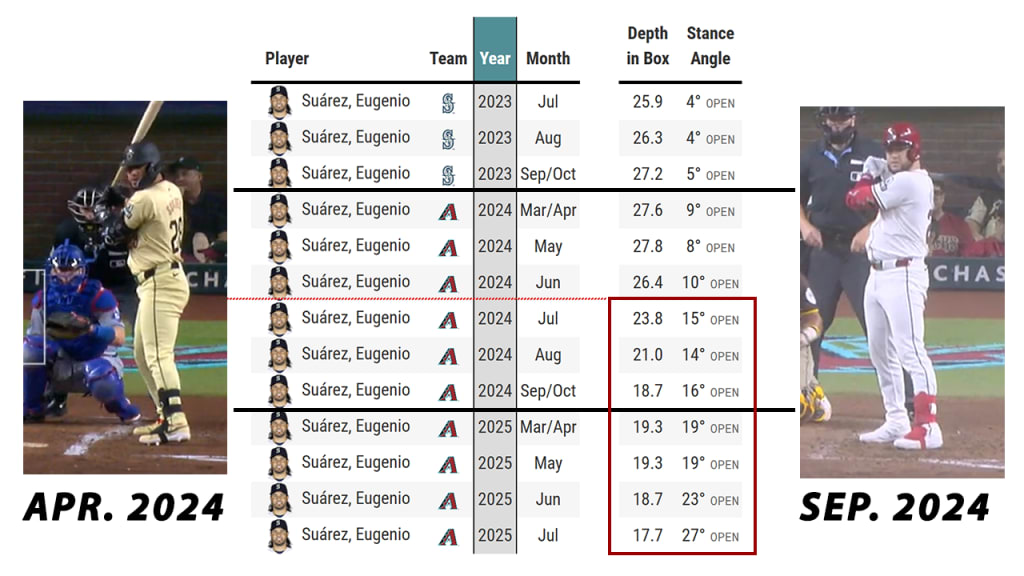During the 2023-24 offseason, the Mariners traded Eugenio Suárez, their third baseman of the previous two seasons, to Arizona. Less than two years later, the night before Thursday's Trade Deadline, they worked out a deal to bring him back to Seattle for the team's playoff chase.
Now, let's think back to the first deal. The Mariners got a relatively limited return, player-wise – the deal was recalled as one of several that winter meant to serve “cost-cutting purposes to reallocate payroll as [Seattle] attempted to reimagine their offense.” That's an industry-speak way of saying they weren’t sure Suárez would be worth a contract paying him more than $26 million combined in 2024-25.
The Mariners were correct -- at first. For the first two months of the 2024 season, Suárez was something like the weakest regular hitter in the game, posting a miserable .196/.279/.312 line. He began to lose playing time at the hot corner. There were even some whispers that the D-backs would cut him loose.
They didn’t. A year later, Suárez is (of course) a year older, and he’s merely two months away from free agency, and the Mariners just gave up more to acquire him than they received from Arizona in the first place. Seller’s remorse? Two seasons spent regretfully ruminating on a deal they wish they’d never made?
Perhaps. But there’s a key component here: This may be the same man in the same uniform we saw for two seasons in Seattle, but this is a very different Suárez than the one they shipped south two winters ago.
A year after wondering if his roster spot was in peril, Suárez arrived at this Trade Deadline as the near-universally acclaimed Best Hitter Available, with 36 home runs to his credit in 2025.
Maybe, then, the Mariners aren’t going back on the deal. They’re just acquiring a very different hitter than the one they had.
Start here: Suárez, in 2023, the final year of his first stint with the Mariners, posted 214 strikeouts and a 103 OPS+, which is another way of saying that he was a league-average hitter, two years after posting a dreadful .198/.286/.428 line in his final season with Cincinnati. It was the third time in four years, around a strong 2022, that he’d been a league-average hitter or worse. As FanGraphs wrote at the time of the trade to Arizona, “Suárez looks like an average contributor in 2024. Expecting him to reprise his excellent 2022 seems unlikely.”
For most of the first half, Suárez wasn’t excellent, or even average. Through the end of June, he was the second-weakest qualified hitter in baseball, ahead of only then-Atlanta shortstop Orlando Arcia. Average? He was, as respectfully as it can be put, bad. But he got a hit on July 1, and doubled twice the next day, and crushed four homers in seven games just before the All-Star break, and ever since then, he hasn’t just been better. He’s been outstanding. He’s been one of the top 10 hitters in the entire sport for more than a year now.
Highest OPS, July 1, 2024, through July 31, 2025 (min. 500 PA)
- 1.167 // Aaron Judge
- 1.004 // Shohei Ohtani
- .973 // Ketel Marte
- .939 // Vladimir Guerrero Jr.
- .932 // Byron Buxton
- .930 // Suárez
- .929 // Bobby Witt Jr.
- .928 // Kyle Schwarber
- .914 // Juan Soto
You don’t go from “being so bad that you’re hanging on to a roster spot by a thread” to “out-hitting Juan Soto” by mistake. All it took was a massive change in the way Suárez approached his job at the plate. Fortunately for us, we have lots of video and data to show exactly what he did – and the words of the player himself.
“Last year,” he told MLB Network on April 1, “I tried something in the beginning of the season, to be short [to the ball], to get that strikeout [rate] to be less. I tried that, and it didn’t work, and this game is about adjustments, so I had a conversation with our hitting coach, and they gave me a little tip.”
That tip? Just a massive in-season change to the way he sets up, opening up his stance, moving up in the box by nearly an entire foot from the start of last year until now, and raising his hands so that the bat rests lightly on his shoulders.

Much like his teammate Corbin Carroll, an offseason change intended to improve contact against high fastballs backfired entirely, and cost months of poor play before it became clear another change was needed. “I tried to turn my hip in to the pitcher, and try to catch the breaking ball out front of the plate, and obviously I got a good result, and I got confident on that, and I just got it natural now.”
You can see it really clearly with this Statcast visualization, showing the changes in his feet by month.
Most interestingly, not trying so hard to avoid strikeouts seems to have been more impactful than the opposite. In his final year with Seattle, Suárez struck out 30% of the time, but in his miserable first two months of 2024, that dropped only to 28% – hardly a worthwhile tradeoff. That didn’t really change at all for the second half when he was crushing the ball, and this year, he’s got the best of both worlds, posting a 26.8% K rate that is his lowest since 2018. (It is, of course, still a ton of strikeouts. He will never be Steven Kwan.)
Suárez still swings and misses as much as he ever has. But as he said in April, the stance change, and moving up in the box, helped him see the breaking ball and not chase. That actually hasn't really been what's happened, as he's chasing more than ever before. Still, moving up in the box has not only helped Suárez catch the ball out front, as he said, it's helped him post one of the more elite rates of pulling the ball in the air, which is of course an ideal way to find homers.
Suárez may not continue to be a top-10 hitter indefinitely, in no small part because he’s going from one of the best hitting parks for righty batters to absolutely the worst. (It’s worth noting that 24 of his 36 homers this year came in the friendly confines of Arizona, as well as a slugging percentage nearly 200 points higher.) But he’s also not the guy that the Mariners were willing to trade for a small return two winters ago, nor is he the one who nearly played his way off Arizona's roster in 2024.
He’s a new hitter, entirely.
